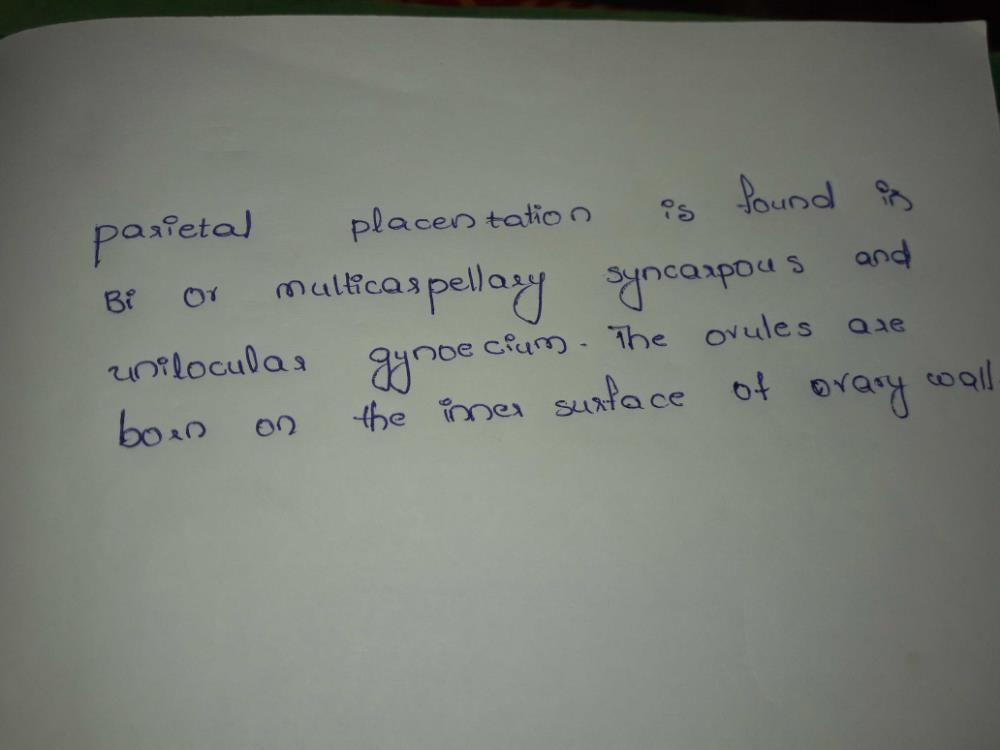NEET Exam > NEET Questions > Placentation in a syncarpous, unilocular ovar...
Start Learning for Free
Placentation in a syncarpous, unilocular ovary bearing two or more placentae longitudinally along the wall is called
- a)Apical
- b)Parietal
- c)Axile
- d)Marginal
Correct answer is option 'B'. Can you explain this answer?
| FREE This question is part of | Download PDF Attempt this Test |
Verified Answer
Placentation in a syncarpous, unilocular ovary bearing two or more pla...
Placentation in a syncarpous, unilocular ovary bearing two or more placentae longitudinallyalong the wall is called parietal placentation.
Most Upvoted Answer
Placentation in a syncarpous, unilocular ovary bearing two or more pla...

Free Test
FREE
| Start Free Test |
Community Answer
Placentation in a syncarpous, unilocular ovary bearing two or more pla...
Parietal - A syncarpous, unilocular ovary bears two or more placentae longitudinally along the wall. for example Damaris, viola. a false septum or replum occurs between two parietal placentae in mustard. it makes ovary falsely bilocular.
Attention NEET Students!
To make sure you are not studying endlessly, EduRev has designed NEET study material, with Structured Courses, Videos, & Test Series. Plus get personalized analysis, doubt solving and improvement plans to achieve a great score in NEET.

|
Explore Courses for NEET exam
|

|
Similar NEET Doubts
Placentation in a syncarpous, unilocular ovary bearing two or more placentae longitudinally along the wall is calleda)Apicalb)Parietalc)Axiled)MarginalCorrect answer is option 'B'. Can you explain this answer?
Question Description
Placentation in a syncarpous, unilocular ovary bearing two or more placentae longitudinally along the wall is calleda)Apicalb)Parietalc)Axiled)MarginalCorrect answer is option 'B'. Can you explain this answer? for NEET 2024 is part of NEET preparation. The Question and answers have been prepared according to the NEET exam syllabus. Information about Placentation in a syncarpous, unilocular ovary bearing two or more placentae longitudinally along the wall is calleda)Apicalb)Parietalc)Axiled)MarginalCorrect answer is option 'B'. Can you explain this answer? covers all topics & solutions for NEET 2024 Exam. Find important definitions, questions, meanings, examples, exercises and tests below for Placentation in a syncarpous, unilocular ovary bearing two or more placentae longitudinally along the wall is calleda)Apicalb)Parietalc)Axiled)MarginalCorrect answer is option 'B'. Can you explain this answer?.
Placentation in a syncarpous, unilocular ovary bearing two or more placentae longitudinally along the wall is calleda)Apicalb)Parietalc)Axiled)MarginalCorrect answer is option 'B'. Can you explain this answer? for NEET 2024 is part of NEET preparation. The Question and answers have been prepared according to the NEET exam syllabus. Information about Placentation in a syncarpous, unilocular ovary bearing two or more placentae longitudinally along the wall is calleda)Apicalb)Parietalc)Axiled)MarginalCorrect answer is option 'B'. Can you explain this answer? covers all topics & solutions for NEET 2024 Exam. Find important definitions, questions, meanings, examples, exercises and tests below for Placentation in a syncarpous, unilocular ovary bearing two or more placentae longitudinally along the wall is calleda)Apicalb)Parietalc)Axiled)MarginalCorrect answer is option 'B'. Can you explain this answer?.
Solutions for Placentation in a syncarpous, unilocular ovary bearing two or more placentae longitudinally along the wall is calleda)Apicalb)Parietalc)Axiled)MarginalCorrect answer is option 'B'. Can you explain this answer? in English & in Hindi are available as part of our courses for NEET.
Download more important topics, notes, lectures and mock test series for NEET Exam by signing up for free.
Here you can find the meaning of Placentation in a syncarpous, unilocular ovary bearing two or more placentae longitudinally along the wall is calleda)Apicalb)Parietalc)Axiled)MarginalCorrect answer is option 'B'. Can you explain this answer? defined & explained in the simplest way possible. Besides giving the explanation of
Placentation in a syncarpous, unilocular ovary bearing two or more placentae longitudinally along the wall is calleda)Apicalb)Parietalc)Axiled)MarginalCorrect answer is option 'B'. Can you explain this answer?, a detailed solution for Placentation in a syncarpous, unilocular ovary bearing two or more placentae longitudinally along the wall is calleda)Apicalb)Parietalc)Axiled)MarginalCorrect answer is option 'B'. Can you explain this answer? has been provided alongside types of Placentation in a syncarpous, unilocular ovary bearing two or more placentae longitudinally along the wall is calleda)Apicalb)Parietalc)Axiled)MarginalCorrect answer is option 'B'. Can you explain this answer? theory, EduRev gives you an
ample number of questions to practice Placentation in a syncarpous, unilocular ovary bearing two or more placentae longitudinally along the wall is calleda)Apicalb)Parietalc)Axiled)MarginalCorrect answer is option 'B'. Can you explain this answer? tests, examples and also practice NEET tests.

|
Explore Courses for NEET exam
|

|
Suggested Free Tests
Signup for Free!
Signup to see your scores go up within 7 days! Learn & Practice with 1000+ FREE Notes, Videos & Tests.
























